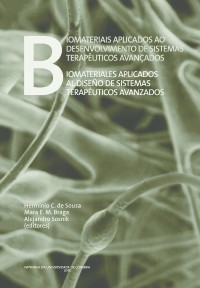Please use this identifier to cite or link to this item:
https://hdl.handle.net/10316.2/36871| Title: | Aplicaciones de la tecnología de radiación de microondas en la síntesis de biomateriales. | Other Titles: | Microwave radiation technology applied to biomaterials synthesis. | Authors: | Sosnik, Alejandro Gotelli, Gustavo |
Keywords: | Microwave-assisted synthesis of polymeric biomaterials;Ring opening polymerization;Graft polymerization;Hydrogels;Microparticles and nanoparticles;Composites;Síntesis de biomateriales poliméricos asistida por radiación de microondas;Polimerización de apertura de anillo;Polimerización de injerto molecular;Hidrogeles;Micropartículas y nanopartículas;Materiales compuestos | Issue Date: | 2015 | Publisher: | Imprensa da Universidade de Coimbra | Journal: | http://hdl.handle.net/10316.2/36860 | Abstract: | The industrial scale-up of the production of synthetic and semi-synthetic polymeric biomaterials faces challenges due to the limited reproducibility and difficult standardization of the synthetic methods. The scale-up demands the adjustment of the process variables, a phase that is crucial and that is associated with the growth of the production costs. In addition, several common synthetic pathways involve the use of organic solvents that are volatile, flammable or toxic that are apparently viable at small scale but that become inviable under an industrial setting, especially because they increase the final price of the product and have a detrimental effect on the environment. These drawbacks have substantially reduced the spectrum of biomaterials that have been succesfully implemented in clinics. Thus, a majority of developments employ biomaterials with a long experience in the market. The technology of microwave radiation has demonstrated a number of advantages that, in the last two decades, have promoted its application in organic synthesis at the laboratory scale. Among them, shorter reaction times, greater yields, the generation of smaller amounts of by-products and relatively straightforward scale-up. This has open the application of this technology in the synthesis of polymers and ceramic materials for biomedical applications.
This chapter presents a State-of-the-Art of the most relevant applications of microwave radiation for the synthesis of organic and inorganic polymeric biomaterials and discusses its potential to optimize the bench-to-bedside translation of new biomaterials. El escalado industrial de la producción de biomateriales poliméricos sintéticos y semi-sintéticos enfrenta desafíos relevantes como la limitada reproducibilidad y difícil estandarización de los procesos sintéticos. Dicho escalado demanda del ajuste de las variables de proceso, etapa que en muchos casos es crítica y que se encuentra asociada al aumento de los costos de producción. Además, muchas de las reacciones de síntesis de los polímeros más comunes involucran el uso de solventes orgánicos volátiles, inflamables o tóxicos que son aparentemente viables en pequeña escala pero que se tornan inviables a la hora de la producción industrial, fundamentalmente porque aumentan de forma drástica el costo del producto final y tienen un efecto nocivo sobre el medio ambiente. Estas desventajas han reducido notablemente el número de biomateriales que han sido implementados en la clínica. Así la mayoría de los desarrollos emplean biomateriales que ya han ganado extenso reconocimiento en el mercado. La tecnología de radiación de microondas ha demostrado ventajas importantes que han hecho que en los últimas dos décadas su empleo en síntesis orgánica se haya extendido mucho en la escala de laboratorio. Entre ellas, tiempos de reacción más cortos, rendimientos de reacción más elevados, formación más limitada de subproductos y escalado más o menos directo con ajustes moderados de las condiciones reacción. Esto ha dado lugar también, más recientemente, a su implementación en la síntesis de polímeros y materiales cerámicos para aplicaciones terapéuticas. El presente capítulo presenta el Estado-del-Arte de las aplicaciones más destacadas de esta tecnología en la síntesis de biomateriales poliméricos orgánicos e inorgánicos y discute el potencial de la misma para optimizar la transferencia a la clínica de nuevos biomateriales. |
URI: | https://hdl.handle.net/10316.2/36871 | ISBN: | 978-989-26-0880-8 978-989-26-0881-5 (PDF) |
DOI: | 10.14195/978-989-26-0881-5_7 | Rights: | open access |
| Appears in Collections: | Biomateriais aplicados ao desenvolvimento de sistemas terapêuticos avançados |
Files in This Item:
| File | Description | Size | Format | |
|---|---|---|---|---|
| cap_tulo_7_-_aplicaciones_de_la_tecnolog_a_de_radiaci_n_de_microondas_en_la_s_ntesis_de_biomateriales.pdf | 2.88 MB | Adobe PDF |  |
Items in DSpace are protected by copyright, with all rights reserved, unless otherwise indicated.
